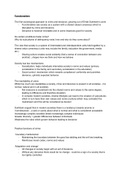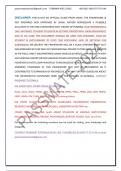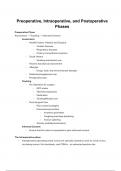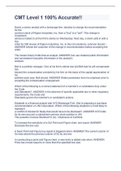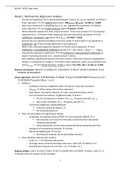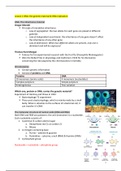Functionalism
The first sociological approach to crime and deviance, growing out of Emile Durkheim’s work
- Functionalists see society as a system with a shared valued consensus which is
disrupted by crime and deviance
- Deviance is however inevitable and in some instances good for society
Do certain conditions foster crime?
Why do subcultures of delinquency exist; how and why do they come about?
The view that society is a system of interrelated and interdependent units held together by a
shared value consensus (units may include the family, education the government, media
etc.)
- Sharing culture creates social solidarity (feel a sense of connection between one
another) , shapes how we think and how we behave
Society has two mechanisms:
- Socialization: helps individuals internalise society’s norms and values (primary
socialization in the family and secondary socialization in the education)
- Social control: mechanism which rewards compliance/ conformity and punishes
deviance, upholds expected behavior.
The inevitability of crime
Whilst too much can destabilise a society, crime and deviance is present in all societies - it is
normal, natural and in all societies
- Not everyone is socialized into the shared norms and values to the same degree,
leading to difference and therefore deviation.
- In complex modern societies, diverse lifestyles can lead to the creation of subcultures
which in turn have their own values and norms (culture) which may contradict the
mainstream and this will be considered as deviant
Durkheim argued that in modern societies there is a tendency towards anomie or
‘normlessness’ - a lack or surety about what is normal and what is considered acceptable
Increasingly complex societies breed increasingly complex individuals
Greater diversity = greater differences between individuals
Weakness the rules which govern behavior leading to deviance
Positive functions of crime
‘ boundary maintenance’
- Maintaining the boundary between the good law abiding and the evil law breaking
- Reinforces moral codes, norms and values
‘Adaptation and change’
- All changes in society begin with an act of deviance
- Without any deviance there would be no change - could be a sign of a society that is
too tightly controlled
, - Think: votes for women, the end of slavery, legislation of homosexuality
Social cohesion
- After a horrific crime it brings society together
Other functions of crime/ deviance
1. Kingsley Davis: prostitutions is a safety valve for men’s seuxal frustration, does not
threaten the monogamous nuclear family.
2. Ned polsky: pornography is a safe channel for sexual desires, does not threaten the
monogamous nuclear family in the way that adultery would
3. Albert cohen: deviance is a warning signal that something in society is not working
properly, a single to policymakers or political leaders
4. Kai Erikson: institutions in society actually exist to ensure crime occurs (including the
police) as this ensures that society stays together. Boundary maintenance
Can there ever be sanctioned rule breaking → turning a blind eye for the greater good.
Allows people to get away with low level crimes to ‘let off some steam’ maybe acting as a
safety valve. Easing the transition from childhood into adulthood.
Criticisms of Durkheim
- He argues that some deviance is good, too much is bad - but how do we know how
much is too much?
- Might explain its function (to create social solidarity) but does not explain why it exists
in the first place.
- Functional for whome - the punishment of a murder may help society but is clearly
not functional for the murdered victim
- Crime does not always promote solidarity it can promote fear and cause isolation
from some individuals
Merton’s strain theory
- People engage in deviant behaviour when they are unable to achieve socially
approved goals by legitimate means
He adapted Durkheim’s idea of anomie (normlessness ) to explain deviance
- Structural factors: society’s unequal opportunity structure
- Cultural factors: strong emphasis on success goals, weaker emphasis on using
legitimate means to achieve them.
Therefore deviance for merton is a strain between:
- The goals that a culture encourages individuals to achieve
- What the structure of society allows individuals to achieve legitimately
The american dream
- American culture values big money success
- Americans expected to pursue the dream by legitimate means
- Belief in meritocracy - reality very different
, - Widespread disadvantages discrimination, poverty etc.
- Goal of money and success lack of opportunity via legitimate means, leads to stress
and strain - and therefore (potentially) deviance
- The norms to prevent deviance are not strong enough
Individual’s position in the social structure affects the way they respond to strain/ anomie.
There are 5 types of adaptation depending on whether an individual accepts,, rejects or
replaces approved culture goals and the legitimate means of achieving them
1. Conformity → these are people who accept the goals in society and the legitimate
ways to achieve them - conforming to the norm. I.e. getting a job , working hard etc.
2. Innovation → accept the goals but not the ways of achieving them so they turn to
crime to get money and success
3. Ritualism → these individuals no longer accept the goals and no longer feel that they
are possible to achieve they still act in the legitimate way - life becomes a ritual
4. Retreatism → reject goals and ways in which to achieve it, they retreat away from
society e.g. drug abusers
5. Rebellion → reject goals and means of gaining them and aim to flip society and
create a new society that wants to bring new goals and ways of achieving them. E.g.
political revolutionaries
Evaluation
- Shows how normal and deviant behaviour can arise from the same goals
- Most crime in america is property crime, because material wealth is valued so highly
- Lower class crime rate is higher, because they have the least opportunities
- Working class crime is overrepresented in crime figures, working classes experience
most crime but yet most do not deviate. Absence of focus on white collar crime
- marxists : ignores the powers of the ruling class, who enforce laws in a way that
criminalise the poor but not the rich
- Assumes all share the money success value goal
- Assumes all crime is towards these ends; utilitarian what about violence and
vandalism
- Accounts for individual deviance but what about group deviance (e.g. subcultures)
Subcultural strain theory
- Seeks to criticize merton’s theories and build upon them
- Claims deviance is a product of a delinquent or deviant subculture, who posses
different values to mainstream culture
- Creation of an alternative structure of merit and achievement
- Mainly a working class phenomenon
Albert Cohen
Status frustration
- Deviance is largely a lower class phenomenon
- Inability of lower classes to achieve mainstream success goals via legitimate
methods
The first sociological approach to crime and deviance, growing out of Emile Durkheim’s work
- Functionalists see society as a system with a shared valued consensus which is
disrupted by crime and deviance
- Deviance is however inevitable and in some instances good for society
Do certain conditions foster crime?
Why do subcultures of delinquency exist; how and why do they come about?
The view that society is a system of interrelated and interdependent units held together by a
shared value consensus (units may include the family, education the government, media
etc.)
- Sharing culture creates social solidarity (feel a sense of connection between one
another) , shapes how we think and how we behave
Society has two mechanisms:
- Socialization: helps individuals internalise society’s norms and values (primary
socialization in the family and secondary socialization in the education)
- Social control: mechanism which rewards compliance/ conformity and punishes
deviance, upholds expected behavior.
The inevitability of crime
Whilst too much can destabilise a society, crime and deviance is present in all societies - it is
normal, natural and in all societies
- Not everyone is socialized into the shared norms and values to the same degree,
leading to difference and therefore deviation.
- In complex modern societies, diverse lifestyles can lead to the creation of subcultures
which in turn have their own values and norms (culture) which may contradict the
mainstream and this will be considered as deviant
Durkheim argued that in modern societies there is a tendency towards anomie or
‘normlessness’ - a lack or surety about what is normal and what is considered acceptable
Increasingly complex societies breed increasingly complex individuals
Greater diversity = greater differences between individuals
Weakness the rules which govern behavior leading to deviance
Positive functions of crime
‘ boundary maintenance’
- Maintaining the boundary between the good law abiding and the evil law breaking
- Reinforces moral codes, norms and values
‘Adaptation and change’
- All changes in society begin with an act of deviance
- Without any deviance there would be no change - could be a sign of a society that is
too tightly controlled
, - Think: votes for women, the end of slavery, legislation of homosexuality
Social cohesion
- After a horrific crime it brings society together
Other functions of crime/ deviance
1. Kingsley Davis: prostitutions is a safety valve for men’s seuxal frustration, does not
threaten the monogamous nuclear family.
2. Ned polsky: pornography is a safe channel for sexual desires, does not threaten the
monogamous nuclear family in the way that adultery would
3. Albert cohen: deviance is a warning signal that something in society is not working
properly, a single to policymakers or political leaders
4. Kai Erikson: institutions in society actually exist to ensure crime occurs (including the
police) as this ensures that society stays together. Boundary maintenance
Can there ever be sanctioned rule breaking → turning a blind eye for the greater good.
Allows people to get away with low level crimes to ‘let off some steam’ maybe acting as a
safety valve. Easing the transition from childhood into adulthood.
Criticisms of Durkheim
- He argues that some deviance is good, too much is bad - but how do we know how
much is too much?
- Might explain its function (to create social solidarity) but does not explain why it exists
in the first place.
- Functional for whome - the punishment of a murder may help society but is clearly
not functional for the murdered victim
- Crime does not always promote solidarity it can promote fear and cause isolation
from some individuals
Merton’s strain theory
- People engage in deviant behaviour when they are unable to achieve socially
approved goals by legitimate means
He adapted Durkheim’s idea of anomie (normlessness ) to explain deviance
- Structural factors: society’s unequal opportunity structure
- Cultural factors: strong emphasis on success goals, weaker emphasis on using
legitimate means to achieve them.
Therefore deviance for merton is a strain between:
- The goals that a culture encourages individuals to achieve
- What the structure of society allows individuals to achieve legitimately
The american dream
- American culture values big money success
- Americans expected to pursue the dream by legitimate means
- Belief in meritocracy - reality very different
, - Widespread disadvantages discrimination, poverty etc.
- Goal of money and success lack of opportunity via legitimate means, leads to stress
and strain - and therefore (potentially) deviance
- The norms to prevent deviance are not strong enough
Individual’s position in the social structure affects the way they respond to strain/ anomie.
There are 5 types of adaptation depending on whether an individual accepts,, rejects or
replaces approved culture goals and the legitimate means of achieving them
1. Conformity → these are people who accept the goals in society and the legitimate
ways to achieve them - conforming to the norm. I.e. getting a job , working hard etc.
2. Innovation → accept the goals but not the ways of achieving them so they turn to
crime to get money and success
3. Ritualism → these individuals no longer accept the goals and no longer feel that they
are possible to achieve they still act in the legitimate way - life becomes a ritual
4. Retreatism → reject goals and ways in which to achieve it, they retreat away from
society e.g. drug abusers
5. Rebellion → reject goals and means of gaining them and aim to flip society and
create a new society that wants to bring new goals and ways of achieving them. E.g.
political revolutionaries
Evaluation
- Shows how normal and deviant behaviour can arise from the same goals
- Most crime in america is property crime, because material wealth is valued so highly
- Lower class crime rate is higher, because they have the least opportunities
- Working class crime is overrepresented in crime figures, working classes experience
most crime but yet most do not deviate. Absence of focus on white collar crime
- marxists : ignores the powers of the ruling class, who enforce laws in a way that
criminalise the poor but not the rich
- Assumes all share the money success value goal
- Assumes all crime is towards these ends; utilitarian what about violence and
vandalism
- Accounts for individual deviance but what about group deviance (e.g. subcultures)
Subcultural strain theory
- Seeks to criticize merton’s theories and build upon them
- Claims deviance is a product of a delinquent or deviant subculture, who posses
different values to mainstream culture
- Creation of an alternative structure of merit and achievement
- Mainly a working class phenomenon
Albert Cohen
Status frustration
- Deviance is largely a lower class phenomenon
- Inability of lower classes to achieve mainstream success goals via legitimate
methods

